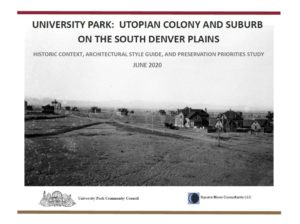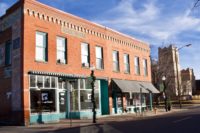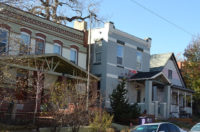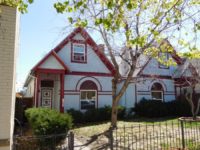RESOURCES
For Neighborhoods
Do you live in an older or historic neighborhood? Are you concerned about a historic property in your community? The resources below provide guidance on neighborhood-level preservation tools, such as historic landmarks, historic districts, conservation overlay district and pattern idea books.
Historic Denver Action Fund
Historic Denver accepts and funds projects for our Action Fund program throughout the year until funds are expended. Applications are provided on an invitational basis. However, potential applicants who have a community project idea are encouraged to contact Historic Denver staff to discuss the project and application process.
The Action Fund is designed to catalyze innovative neighborhood and community projects that enhance the city’s unique identity, tell diverse stories, promote and maintain authentic character, and honor cultural heritage as reflected in the built environment. Through the Action Fund, Historic Denver will select one to three community or neighborhood projects each year. Projects will receive technical assistance, staff support and direct financial investment from Historic Denver, ranging from $2,500 to $15,000.
If you have a project idea that is not listed, please call Historic Denver staff to discuss eligibility.
- National Register Nominations
- Local Historic Designations for Single Site or District (Single Site designations must demonstrate significance to community)
- Story Telling initiatives (i.e. interpretative signs, plaques, walking tour guides)
- Surveys of Historic resources
- Resource studies (includes feasibility/reuse studies and condition assessments for historic properties and projects that will provide community benefit).
- Assess and develop plans to preserve community or cultural resources.
Ineligible Projects:
- Capital construction, restoration or rehabilitation
- Historic Structure Assessments
- Traffic or parking studies
- Heritage projects that do not include a focus on the built environment
- Projects that are currently funded and open with the Colorado State Historical Fund
Eligible applicants will be located in the City & County of Denver and include:
-
501(c)3 non-profit organization
- Registered Neighborhood Organization (RNO)
- Civic or Cultural Organization
- Educational Institution
- Community Group – Community groups do not need to a formal organization, but we will require signed letters of commitment from at least three volunteers to consider the project for funding.
Application Process:
Historic Denver will reach out to help fund applicable projects or interested community organizations, groups, and non-profit organizations may contact Historic Denver to discuss their project ideas. If the project is applicable and funding is available, then staff will set up a time to discuss and fill out the Action Fund Application. After an application is completed, it will be considered by Historic Denver’s Preservation Committee for approval.
If an application is approved a staff member will reach out the applicants to discuss project timeline, project requirements and funding amount.
Historic Denver will cover the cost of the project in full or in allotments, depending on the project once project requirements are met or in progress. This is not a grant program as Historic Denver will cover the costs of the project directly from the Action Fund.
The maximum Project Amount is $15,000 if project cost exceeds this amount, then the applicant is responsible for the remaining amount and must show the ability to cover those additional costs. If project is under $15,000 then Historic Denver may cover full costs. Grant awards are set by the preservation committee and may include partial awards.
The goal of all action fund projects is to be completed within 24 months.
Here are some examples of project requirements that may be set by Historic Denver that the applicant must fulfill to receive funding. Each project will have its own set of requirements and commitments, and this is not a set list nor a comprehensive one.
- Host and run initial community meeting/including inviting community members.
- Commitment to additional community meetings as determined by Historic Denver.
- Signed letter of commitment from at least 3 volunteers to assist with project needs.
- Action Statement clearly defining project goals.
- Meetings with Historic Denver Staff as needed.
- Project Timeline and budget created with Historic Denver Staff assistance.
Selection Criteria:
-
Strong Relationship to the historic built environment
- Wide reaching community impact
- Supports diversity, equity, awareness, inclusivity and access for all people with appreciation for race, ethnicity, religion, gender, ability and identification.
- Helps to tell or preserve Denver’s cultural and physical history.
- Feasible to complete within 24 months.
- Able to be funded in full (either by the Action Fund, or a combination of the Action Fund and applicant funds).
- Promotes community partnerships between cultural organizations, neighborhood organizations, and community members.
The Action Fund is not a grant program. Historic Denver will retain the funds for each project and release the funds directly to cover expenses related to the effort, such as consultant or contractor fees. Funds will not be given to private citizens or property owners.
A six member selection committee will review all applications and make a recommendation to historic Denver’s Board of Trustees. Historic Denver retains the right to select projects at its sole discretion, and may elect to select no projects in any given year.
Those interested in applying should contact Beth Glandon Senior Director of Preservation and Advocacy at 303-534-5288 ext. 23 or bglandon@historicdenver.org.
Each application will require a complete budget spreadsheet but Historic Denver is here to help! Once an application is ready to be submitted Historic Denver staff will work with applicants on developing a budget for the project. You can download an example of the spreadsheet below!
You will need to download the Budget Spreadsheet here: Action Fund Budget Spreadsheet
This is a selection of some current and past Action Fund Projects.
University Park Historic Context Report

University Park Community Council (UPCC) applied to Historic Denver’s action fund and was awarded funding, which the Neighborhood raised the 25% in matching funds. These combined funds went toward hiring Square Moon Consultants, LLC to research the neighborhood’s history and identify significant people and homes that were a part of making this neighborhood a unique area of Denver. The evolution of University Park began when the Colorado Seminary (eventually evolving into the University of Denver) moved south to escape the increasingly unsavory aspects of downtown Denver. The donation of land and funding stipulated that an adjacent neighborhood – today’s University Park – be developed based on temperance and conscience. Land development and construction of homes in this new Utopian southern colony included homes closely associated with the Colorado Seminary/University of Denver (DU) donors and professors. Ultimately, this project will assist University Park neighbors in preservation initiatives, including online and in person walking tours highlighting the neighborhood’s people, architecture, providing research documents online, and identifying significant properties and areas in the neighborhood.
You can view the University Park Historic Context here.
South Pearl Street Design Overlay

Platt Park People’s Association is a five-member community group within the Registered Neighborhood Organization (RNO) that applied to Historic Denver’s Action Fund in 2017 to pursue a design overlay for the neighborhoods beloved commercial corridor. After threats of demolition, and increasingly large infill, neighbors want to ensure that “Old South Pearl” retains its unique character, intact since Denver’s streetcar days. The overlay effort is designed to encourage preservation and ensure that future development honors the qualities that make this one of Denver’s most popular areas. The group has begun public discussions about the street’s character with all building owners including the Pearl Street Merchants Association, which have been proceeding with positive feedback on creating a Design Overlay.
Click here to learn more about this project and review the initial Overlay Strategy Brochure created by the City’s Community Planning Department. This project continues to evolve as we work with the community and business owners to determine the best strategy for this streetcar commercial district.
Photo: Alkire block at the corner of S. Pearl St. and Iowa Ave, built in 1891. Cameron Church is the only Landmarked building on this part of Pearl Street. Photo by Lucy Graca.
River Drive Historic District

The River Drive Historic District is a block of 19 properties with 16 contributing homes curving toward the S. Platte River and I-25 from W. 23rd Ave and Clay Street. Many of the homes on the block are tied to the history of the Zang Brewery east of River Drive, and nearby railroad companies. This project was a community-driven effort with a group of neighbors who applied to Historic Denver’s Action Fund in 2018. The funds were used to hire a consultant to research and write the historic district application for the River Drive block. The homeowners applied to our Action Fund because they were very concerned about surrounding blocks in their neighborhood that were being demolished and replaced with slot homes. This group had the support of their RNO and their City Councilman. River Drive Historic District preserves a variety of early Denver architectural styles and early Denver history, and ensures a slice of Denver’s character is preserved for future generations.
La Alma Lincoln Park Neighborhood Resource Survey

La Alma Lincoln Park Neighborhood Association applied to the Historic Denver Action Fund to complete a neighborhood resource survey. More than 90% of the homes in this area were built in the 1800s, and the area is significant for its role in early Denver, and for 1970s-era activism as part of the Chicano movement. The survey includes community engagement and oral histories, and will provide the foundation for future action that ensures this important part of our city’s architecture and history is not lost. The community is currently pursuing a Historic Cultural District with input from a number of community meetings. You can find out about upcoming meetings in the neighborhood on Historic Denver’s Facebook page.
The Historic Context document has been completed from this project and is available for download here: La Alma Lincoln Park Historic Context.
Click on the following projects to see recent examples of successful Action Fund applications:
Conservation Districts
When Denver updated the city zoning code in 2010 it included a new tool, the Conservation Overlay District. Conservation Overlay District are different than historic districts because they do not regulate demolition of historic structures and do not require design review of modifications. However, conservation overlay districts can create special zoning that supports the character of a neighborhood.
For example, if your neighborhood is a low-slung, mid-century neighborhood you can create zoning that reinforces these attributes and requires new construction to meet certain, objective, parameters. If you neighborhood has tall homes on narrow lots, a conservation district can provide the opportunity to built a little differently than allowed in a typical zone district. Like historic districts, conservation districts must ultimately be approved by the Denver City Council. Unlike historic districts conservation districts require 51% landowner consent.
On November 21, 2016 Denver City Council unanimously approved the CO-5 Conservation Overlay for Krisana Park. This overlay provides customized zoning provisions that will encourage continuity and the preservation of the neighborhood’s character, and it makes it simpler for owners to renovate and add to their homes while honoring the original design and aesthetic of the neighborhood. It is intended to maintain the distinctive features of the California Contemporary style, including:
- Low pitched roof lines
- Low profile, single-story building heights
- Compatible additions
Pattern & Design Idea Books
Historic Denver has created four Pattern and Design Idea Books to provide inspiration to homeowners that reside in neighborhoods that characterize a particular period from our history, but are in areas that are gaining popularity and are experiencing development pressure. Both minor remodels, which don’t alter the exterior of the home, and major remodels, which increase the square footage of the home, are presented. To view the Pattern and Design Idea Books for Krisana Park in Denver, Pre-WWII Homes in Arvada, Post-WWII Homes in Arvada, and Post-WWII Homes in Aberdeen Village, Littleton.
KRISANA PARK
The Krisana Park Pattern and Idea Book is now complete! This project was funded by the National Trust for Historic Preservation, Historic Denver’s Action Fund, and through individual donations from neighbors in Krisana Park, and produced in partnership with the Center of Preservation Research at the University of Colorado, Denver.
Krisana Park is an excellent case study of Mid Century Modern architecture in Denver. It is also an area that is gaining in popularity and so far has been shielded from the development pressure that is present in many of Denver’s most historic neighborhoods. The book illustrates contemporary remodels and additions that can add much needed space to these homes while also honoring the historic aesthetic of the neighborhood.
On November 21, 2016 Denver City Council will consider a conservation overlay for Krisana Park so that this special character is honored!
You can purchase a copy of the pattern book today, quantities are limited!
ARVADA
Historic Denver Inc., in partnership with the City of Arvada and the Colorado Center for Community Development, has developed two Pattern and Design Idea Books for home types that are common in Arvada. Each book focuses on a particular era of development, the first being the time prior to World War II, which was primarily characterized by an agricultural economy in Arvada. The second book focuses on the period following the War, which featured explosive population growth and rapid suburban development.
The goal of the Pattern and Design Idea Books is to provide inspiration to homeowners that reside in neighborhoods that characterize a particular period from our history, but are in areas that are gaining popularity and are experiencing development pressure. Both minor remodels, which don’t alter the exterior of the home, and major remodels, which increase the square footage of the home, are presented.
LITTLETON
Historic Denver Inc., in partnership with the City of Littleton and the Colorado Center for Community Development, has developed a Pattern and Design Idea Books for home types that are common in Aberdeen Village Subdivision in Littleton. The book focuses on the era of development following World War II.
Across the nation modest homes are being demolished in order to build larger homes that often do not fit the character of their neighborhood. The full impact of this trend has not yet reached Aberdeen Village, but development pressures are expected to increase as Littleton’s attractive community and proximity to Denver continues to draw new residents to the area. By looking at the success of similar projects (notably Minnesota’s ‘Cape Cod and Ramblers’ Pattern Book and Wheat Ridge’s ‘Ranch Renovation’ Idea Book), it was decided that a pattern book would be a valuable tool for homeowners to visualize sensitive home modifications.
The majority of Aberdeen Village’s housing stock is comprised of single and split level ranch homes. Though the architectural details vary in terms of materials and window placement, the housing forms are similar. A community meeting was held early during the planning phase for this patternbook, both to establish interest within the community and to determine which housing types residents would like to see included. Prior to the meeting the neighborhood was surveyed, photographed, and the homes grouped by type.
Members of the community reviewed the survey materials, and five housing types were chosen for inclusion in the Pattern and Design Idea book. The housing types, named for their form, are:
- Side Gable Ranch
- Front Gable Ranch
- Hipped Roof Ranch
- Cross Gable Ranch
- Asymmetrical Split-Level Ranch
PATTERN & DESIGN IDEA BOOK FOR POST-WWII HOMES IN ABERDEEN VILLAGE, LITTLETON
Historic Designation (Landmarks & Districts)
Historic designation is one method of ensuring that changes to a neighborhood occur thoughtfully, preserving the fabric of a neighborhood that people love — homes with history, vital dwellings that preserve the past — while acknowledging modern lifestyles. Navigating the ins and outs of the designation process and what it means for your property, however, can be a difficult task. We’ve created a Historic Designation FAQ guide, which answers many of the questions we commonly receive from property owners. If you are interested in pursuing designation for your home or neighborhood, contact Preservation Services Manager Mike Owen at 303-534-5288, ext. 25.
View FAQ about Historic Designations (Landmarks & Districts)
Are you interested in proposing a historic district for your neighborhood? Or do you want to individually designate your home? Local historic district or individual landmark designation is the most common form of historic designation in Denver, and the most useful in terms of offering protection from demolition and design review. National or State Register of Historic Places designation is an honorary designation and can have a financial benefit in the form of tax credits, but it does not protect against demolition.
Ultimately a formal application for a local historic district or individual landmark must be submitted to the Denver Landmark Commission and then approved by City Council, but there are many steps to take before initiating the formal process. Follow the steps below to get started!
Historic Denver can speak at community meetings, provide information about the district or individual designation process, and provide research advice so that you don’t have to reinvent the wheel! If you are looking into a Historic District for your neighborhood you can also apply for direct support from Historic Denver through our Action Fund (although individual designations do not qualify for the Action Fund).
As a reminder, Historic Denver is a non-profit advocacy organization and does not grant historic designations; we provide support through the process. The process and ultimate decisions are conducted through the City & County of Denver, Community Planning & Development Department and the Denver Landmark Commission.
1) Review the Requirements
The City of Denver processes local landmark designations. You can find the required criteria, application, and sample applications on the Denver Landmark website. If you are interested in State Register or National Register visit our designation FAQs for more information.
2) Form an Exploratory Committee (for Historic Districts)
Identify neighbors who are interested in designation and organize a committee to lead the effort, conduct volunteer tasks, raise funds, and demonstrate grassroots support. This group must be committed to seeing the project through from beginning to end. Also, make contact with your Registered Neighborhood Organization (RNO) if one is active in your area.
3) Agree on Preliminary District Boundaries (for Historic Districts)
Using initial understanding about an area’s history and geography establish a preliminary boundary for the proposed district. The boundary may shift some as additional research is completed. Selecting a smaller, more cohesive area is generally more manageable than selecting a very large area, but historic districts range in size from one block to several hundred homes.
4) Check-in with the Denver Landmark Commission
Before you get too far it’s wise to check-in with the Denver Landmark Preservation Commission staff. You can review the requirements for historic districts or individual landmarks, discuss what makes for a strong application, and gain important feedback and guidance regarding whether the area is likely to meet the eligibility criteria. You can reach the staff at landmark@denvergov.org.
5) Create A Map & Survey (for Historic Districts)
With the preliminary boundaries agreed upon, create a map of the proposed area. Conduct a “windshield” survey, photographing each property and researching its year of construction through the Denver Assessor’s office. This will help establish a period of significance for the district, which is essential in defining which properties are “contributing” and which are “non-contributing” (because they were built at a later time or lack integrity).
6) Conduct Research
Conduct research on the history, architecture, geography and culture of the proposed district, highlighting particularly important properties. Some neighborhoods elect to conduct this research on their own using dedicated volunteers who are willing to put in significant time to visit the library to research individual properties, larger historical trends affecting the area, and the common architectural styles. Other neighborhoods elect to hire consultants to do this work. For suggested consultants please contact Historic Denver. This same process pertains to researching your individual home for an individual landmark application.
7) Host an Informational Meeting (pertaining to Historic Districts)
It is important to host at least district-wide meeting early in the process. This provides property owners the opportunity to learn more about the process, express concerns and ask questions. Provide written information so owners have something to refer to during the meeting and once they go home. We suggest using Historic Denver’s FAQ on historic designation. This meeting can be held at the very beginning of the effort, or after initial research is complete, but should definitely take place before a designation application is submitted. Be sure to publicize the meeting widely. After an application is submitted the City of Denver will also host a required public meeting to gather input on the proposal.
8) Communicate, Communicate, Communicate! (for Historic Districts)
Communication early and often is key to the success of any historic district proposal. Be sure to reach out to all property owners in the proposed district with basic information by delivering fliers door to door, sending registered letters, and hosting a number of community-wide meetings to discuss the district application, gain feedback from the community and provide updates on the process. Identifying a block captain for each block affected by the district may help, in the door to door communication. This outreach should be done at several stages of the process and in advance of any public hearings. Keep a list of each outreach effort to demonstrate that ample effort was put into informing all property owners about the project.
9) Prepare & Submit the Designation Application
Applications must be thorough and well-researched and demonstrate that the proposed district and individual landmark meets the criteria established in Denver’s Landmark Preservation Ordinance; these criteria include architecture, history, geography and culture. District applications must also identify which properties are “contributing” and which are “non-contributing.” Again, this can be done by volunteers or by a professional consultant. The application form, instructions, and samples can be found here. The application, along with the required fee, is submitted to the Landmark Preservation Commission.
10) Attend Public Hearings & Meetings
Once your application is submitted a formal process begins, and there will be several opportunities for property owners to provide their perspective. The Landmark Commission will hold a public hearing, and if they recommend the application, City Council will also host a public hearing. It is important to demonstrate great support at these hearings, so publicize them to all property owners and rally supporters to attend.
11) Celebrate Success!

